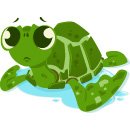|
|
If you have a water turtle you should first determine
exactly which species your turtle belongs to, and then
research what that species needs to be healthy and happy.
There is plenty of information on the Internet about turtles
of all types, just be sure that you find good advice from
people who know what they are talking about.
There are some general rules about the diet of water
turtles, and we'll go over some of them to help you get
started in your plans to keep your turtle healthy and well-fed.
The first thing to consider about the proper diet for your
water turtle is that unlike many land turtles, nearly all
water turtles get many of their nutrients from animal
protein, especially young turtles. Some species such as
Red Eared
Sliders and Painted turtles, however, are primarily
carnivorous when young but vegetarians when adults. Again,
be sure to check out the specific needs of your species.
Most water turtles are omnivorous, meaning that they
basically eat whatever they find: plenty of aquatic plants,
but also snails, tadpoles and small fish, frogs and the
like. Since they eat animals whole, the bones of their prey
usually provides the calcium they must have in their diet.
In captivity people sometimes mistakenly think that they are
treating their turtles well by feeding them only the best
meat, but in truth turtles need the calcium from the
animal's bones, or a good commercial supplement, in order
for their own bones and shells to grow properly.
Since eating bones can cause digestive upsets or even
injury, most turtle keepers prefer to feed a good Calcium
and vitamin D3 supplement. Your pet supply shop can advise
you on the best brands to buy, or you might ask the local
turtle club, if there is one in your area. Many turtle
keepers also float pieces of cuttlebone on the water for
their turtles to gnaw on. Turtles love it and it adds to
their dietary calcium intake.
In any event, please don't just feed your turtle commercial
turtle flakes. Some brands are very poor nutritionally and
don't have necessary vitamins, minerals, or fiber. On the
other end, a diet that consists mainly of fish can lead to
liver problems due to the high fat content, and cause B
vitamin deficiencies because of an enzyme in the fish.
Try to provide a varied and balanced diet of the list below,
in order of quantity from high to low. Give the turtle a
meal of two or three things from the list, and make the next
meal two or three of the other items.
When you feed the pellets or kibble, sprinkle a good reptile
calcium and vitamin D3 powder over it, cover with water and
let it stand for fifteen minutes before feeding. This lets
the food bits absorb some of the calcium powder and so gets
more of it into the turtle, rather than into the water. Dust
the live prey and vegetation with the powder too and your
turtles should get enough.

* Plenty of aquatic plants and edible greens every day
* Good quality commercial turtle food three times per week
* Occasional small amounts of whole raw minnows, feeder
goldfish, or other small fish
* Presoaked low-fat cat kibbles or trout pellets, two times
a week for fry and once per week for adult turtles
* Earthworms,
crickets, Tubifex worms, bloodworms, waxworm
larvae and the like occasionally
* Gravel and small rocks should not be used with aquatic turtles
because it could be life threatening if they accidentally eat some.
* Gravel holds food particles in and rots and makes the water smell
bad and look brownish.
Plush Turtles & Sea Turtles you'll have all kinds of Fun With
|